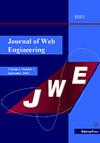A Digital Grid Security Architecture Based on Quantum Key Interaction and Web Engineering for Distributed Energy Systems
IF 1
4区 计算机科学
Q4 COMPUTER SCIENCE, SOFTWARE ENGINEERING
引用次数: 0
Abstract
The modernization of distributed energy systems introduces complex cyber-security challenges as grid infrastructures become increasingly digitized, decentralized, and web-connected. This paper presents a novel security architecture that integrates quantum key distribution (QKD) with semantic web technologies to provide end-to-end secure, scalable, and adaptive protection for distributed energy resource (DER) networks. The proposed framework features a modular system design, incorporating BB84-based QKD protocols for quantum-resilient key generation, a metadata-driven policy layer using OWL ontologies and SWRL reasoning, and a web interface for operator access and real-time monitoring. Extensive performance evaluation in a simulated multi-domain microgrid environment demonstrates that the system achieves an average key generation rate of 2.3 kbps with quantum bit error rate (QBER) maintained below 5.2% across 40 km optical links. Session establishment latency averaged 435 ms, 29.8% lower than a traditional TLS/PKI baseline, while semantic access validation achieved 100% accuracy in 42 adversarial test cases. These cases were evaluated using automated semantic validation scripts simulating spoofed roles, malformed sessions, and unauthorized requests. The system sustained encrypted throughput of 110 messages per second per node and maintained service continuity under quantum noise and cross-domain attack simulations. Usability trials with six engineers yielded a system usability scale (SUS) score of 88.3, and the average DER onboarding time was reduced from 10.1 to 5.5 minutes. These findings affirm that QKD-enhanced, semantically governed web architectures can provide strong cryptographic guarantees while supporting dynamic policy enforcement and intuitive user workflows. The proposed solution demonstrates a viable path for deploying future-proof security mechanisms in next-generation smart grid environments.基于量子密钥交互和Web工程的分布式能源系统数字网格安全体系结构
随着电网基础设施日益数字化、去中心化和网络化,分布式能源系统的现代化带来了复杂的网络安全挑战。本文提出了一种集成量子密钥分发(QKD)和语义web技术的新型安全架构,为分布式能源(DER)网络提供端到端的安全、可扩展和自适应保护。该框架采用模块化系统设计,结合了用于量子弹性密钥生成的基于bb84的QKD协议,使用OWL本体和SWRL推理的元数据驱动策略层,以及用于运营商访问和实时监控的web界面。在模拟多域微电网环境中进行的广泛性能评估表明,该系统在40公里光链路上实现了2.3 kbps的平均密钥生成速率,量子误码率(QBER)保持在5.2%以下。会话建立延迟平均为435 ms,比传统的TLS/PKI基线低29.8%,而语义访问验证在42个对抗性测试用例中实现了100%的准确性。使用自动语义验证脚本模拟欺骗角色、格式错误的会话和未经授权的请求来评估这些情况。在量子噪声和跨域攻击模拟下,系统保持了每个节点每秒110条消息的加密吞吐量,并保持了业务的连续性。六位工程师进行的可用性试验得出了88.3的系统可用性量表(SUS)分数,并且平均使用DER的时间从10.1分钟减少到5.5分钟。这些发现证实,qkd增强的、语义治理的web架构可以提供强大的加密保证,同时支持动态策略实施和直观的用户工作流。提出的解决方案展示了在下一代智能电网环境中部署面向未来的安全机制的可行途径。
本文章由计算机程序翻译,如有差异,请以英文原文为准。
求助全文
约1分钟内获得全文
求助全文
来源期刊

Journal of Web Engineering
工程技术-计算机:理论方法
CiteScore
1.80
自引率
12.50%
发文量
62
审稿时长
9 months
期刊介绍:
The World Wide Web and its associated technologies have become a major implementation and delivery platform for a large variety of applications, ranging from simple institutional information Web sites to sophisticated supply-chain management systems, financial applications, e-government, distance learning, and entertainment, among others. Such applications, in addition to their intrinsic functionality, also exhibit the more complex behavior of distributed applications.
 求助内容:
求助内容: 应助结果提醒方式:
应助结果提醒方式:


